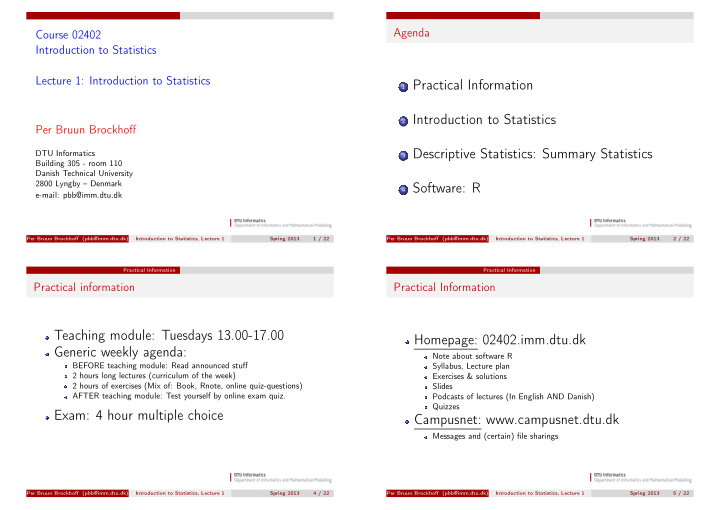



Agenda Course 02402 Introduction to Statistics Lecture 1: Introduction to Statistics 1 Practical Information 2 Introduction to Statistics Per Bruun Brockhoff 3 Descriptive Statistics: Summary Statistics DTU Informatics Building 305 - room 110 Danish Technical University 2800 Lyngby – Denmark 4 Software: R e-mail: pbb@imm.dtu.dk Per Bruun Brockhoff (pbb@imm.dtu.dk) Introduction to Statistics, Lecture 1 Spring 2013 1 / 22 Per Bruun Brockhoff (pbb@imm.dtu.dk) Introduction to Statistics, Lecture 1 Spring 2013 2 / 22 Practical Information Practical Information Practical information Practical Information Teaching module: Tuesdays 13.00-17.00 Homepage: 02402.imm.dtu.dk Generic weekly agenda: Note about software R BEFORE teaching module: Read announced stuff Syllabus, Lecture plan 2 hours long lectures (curriculum of the week) Exercises & solutions 2 hours of exercises (Mix of: Book, Rnote, online quiz-questions) Slides AFTER teaching module: Test yourself by online exam quiz. Podcasts of lectures (In English AND Danish) Quizzes Exam: 4 hour multiple choice Campusnet: www.campusnet.dtu.dk Messages and (certain) file sharings Per Bruun Brockhoff (pbb@imm.dtu.dk) Introduction to Statistics, Lecture 1 Spring 2013 4 / 22 Per Bruun Brockhoff (pbb@imm.dtu.dk) Introduction to Statistics, Lecture 1 Spring 2013 5 / 22
Introduction to Statistics Introduction to Statistics Introduction to Statistics Statistics and Engineers How to treat (or analyse) data? Statistics is an important tool in problem What is random variation? solving Statistics is a tool for making decisions: Data analysis How many computers did we sell last year? Quality improvement What is the expected price of a share? Design of experiments Is machine A more effective than machine B ? Predictions of future values Statistics can be used Statistics can be used in most disciplines and is .. and much more! therefore a very important tool Per Bruun Brockhoff (pbb@imm.dtu.dk) Introduction to Statistics, Lecture 1 Spring 2013 7 / 22 Per Bruun Brockhoff (pbb@imm.dtu.dk) Introduction to Statistics, Lecture 1 Spring 2013 8 / 22 Introduction to Statistics Introduction to Statistics Statistics Statistics Modern statistics Modern statistics are based on theory of probabilities and descriptive Statistics is often about analyzing a sample , statistics. that is taken from a population Based on the sample, we try to generalize (or comment on) the population Therefore it is important that the sample is representative of the population Per Bruun Brockhoff (pbb@imm.dtu.dk) Introduction to Statistics, Lecture 1 Spring 2013 9 / 22 Per Bruun Brockhoff (pbb@imm.dtu.dk) Introduction to Statistics, Lecture 1 Spring 2013 10 / 22
Descriptive Statistics: Summary Statistics Descriptive Statistics: Summary Statistics Chapter 2: Summary statistics Mean We use a number of summary statistics to The mean value is a key number that indicates summarize and describe data (stochastic variables) the centre of gravity or centering of the data Mean x ¯ The mean: n Median x = 1 � ¯ x i s 2 Variance n i =1 Standard deviation s We say that ¯ x is an estimate of the mean value Percentiles Per Bruun Brockhoff (pbb@imm.dtu.dk) Introduction to Statistics, Lecture 1 Spring 2013 12 / 22 Per Bruun Brockhoff (pbb@imm.dtu.dk) Introduction to Statistics, Lecture 1 Spring 2013 13 / 22 Descriptive Statistics: Summary Statistics Descriptive Statistics: Summary Statistics Median Variance and standard deviation The variance (or the standard deviation) indicates the spread of the data: The median is also a key number, indicating the Variance center of the data. In some cases, for example in n 1 s 2 = the case of extreme values, the median is � x ) 2 ( x i − ¯ n − 1 preferable to the mean i =1 Standard deviation Median: � The observation in the middle (in sorted order) n � 1 √ s 2 = � � s = ( x i − ¯ x ) 2 � n − 1 i =1 Per Bruun Brockhoff (pbb@imm.dtu.dk) Introduction to Statistics, Lecture 1 Spring 2013 14 / 22 Per Bruun Brockhoff (pbb@imm.dtu.dk) Introduction to Statistics, Lecture 1 Spring 2013 15 / 22
Descriptive Statistics: Summary Statistics Descriptive Statistics: Summary Statistics The coefficient of variation Percentiles The median it the point that divides the data into The standard deviation and the variance are key two halves. It is of course possible to find other numbers for absolute variation. If it is of interest points that divide the data in other parts, they are to compare variation between different data sets, called percentiles. it might be a good idea to use a relative key Often calculated percentiles are number, the coefficient of variation: 0 , 25 , 50 , 75 , 100 % percentiles (quartiles) V = s and/or x · 100 ¯ 0 , 10 , 20 , 30 , 40 , 50 , 60 , 70 , 80 , 90 , 100 % percentiles Note: the 50% percentile is the median Per Bruun Brockhoff (pbb@imm.dtu.dk) Introduction to Statistics, Lecture 1 Spring 2013 16 / 22 Per Bruun Brockhoff (pbb@imm.dtu.dk) Introduction to Statistics, Lecture 1 Spring 2013 17 / 22 Descriptive Statistics: Summary Statistics Software: R Figures/Tables Software: R Quantitative data: Appendix C in the textbook (7. and 8. edition): Description of R. Scatter plot (xy plot) R Commander: a graphical user interface. Histogram R-exercise today. Cumulative distribution You can run R from the G-bar at home via Boxplots Thinlinc. Count data: R can (easily) be installed on your own Bar charts (pareto diagram) computer. (See Rnote) Pie charts Per Bruun Brockhoff (pbb@imm.dtu.dk) Introduction to Statistics, Lecture 1 Spring 2013 18 / 22 Per Bruun Brockhoff (pbb@imm.dtu.dk) Introduction to Statistics, Lecture 1 Spring 2013 20 / 22
Software: R Software: R Next week: Agenda 1 Practical Information 2 Introduction to Statistics Discrete distributions - chapter 4. 3 Descriptive Statistics: Summary Statistics 4 Software: R Per Bruun Brockhoff (pbb@imm.dtu.dk) Introduction to Statistics, Lecture 1 Spring 2013 21 / 22 Per Bruun Brockhoff (pbb@imm.dtu.dk) Introduction to Statistics, Lecture 1 Spring 2013 22 / 22
Recommend
More recommend